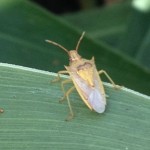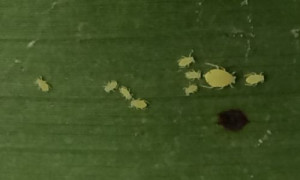We are currently finding a variety of different insects in sorghum fields across the Mid-Coast of Texas. These pests include Sorghum Midge, Stink bugs, Headworms and Aphids.
Field maturity is beginning to be a problem. we are finding field maturity ranging from 5-7 leaf to soft dough. Often these fields are near each other and will end up sharing pests from field to field. Maturity between fields is one problem but some fields have significant differences in maturity across the field depending on where water stood after planting.
Sorghum midge are being found in blooming sorghum fields. Continue to watch blooming sorghum for midge. I suspect the later planted sorghum will have greater problems with midge.
 Stink bugs can cause economic loss fields as they are blooming. We are already finding rice stink bugs in treatable populations. Some of these fields have just begun to bloom.
Stink bugs can cause economic loss fields as they are blooming. We are already finding rice stink bugs in treatable populations. Some of these fields have just begun to bloom.
Fall Armyworms are also being found in whorl stage and headed sorghum. I don’t think the armyworms are damaging to whorl stage sorghum unless they are feeding in the developing head or below it.
I received a text message this past week with a picture of a different kind of caterpillar in the sorghum head. He took the picture with his phone and text it to my mobile phone (361-920-1138). 
The insect in the picture is a sorghum webworm. This is not a common insect problem because we use cultural methods to manage this pest.
Adults are small, white moths active at night. They lay about 100 eggs singly but fastened rather securely to flowering parts or kernels of sorghum. Eggs are round to broadly oval and are flattened from top to bottom. Webworm larvae are somewhat flattened, yellowish or greenish brown and marked with four lengthwise reddish to black dorsal stripes. When mature, larvae are about 1/2 inch long and covered with many spines and much hair. Pupae within a cocoon are reddish brown, slender and sub-cylindrical. A generation requires 1 month; as many as six generations may develop in a year. The larva overwinters in a cocoon on the host plant.
To examine grain heads for sorghum webworms, shake grain heads vigorously into a 2.5- to 5-gallon plastic bucket, where even small larvae can be seen and counted easily. Inspect at least 30 plants from a field to ensure that sample estimates are reasonably reliable. Sample at least one grain head per acre in fields larger than 40 acres.
Insecticide application is economically justified when grain heads are infested with an average of five or more small webworm larvae. Cultural practices to reduce sorghum webworm abundance include plowing sorghum residues after harvest to destroy overwintering pupae, planting as early as practical, and using sorghum hybrids with loose (open) grain heads.
By the way, this is an excellent method for getting an insect identified. If I don’t recognize the insect, I can quickly forward it to a number of others who can ID the insect.
 Along with all of the typical pest issues we still have sugarcane aphids in the fields. I think it is important to treat insect pests as they occur in the field. If midge, stink bugs, or headworms are exceeding the economic threshold, treat them with the appropriate insecticide. This will likely be a pyrethroid. While this may have a negative effect on beneficial numbers resulting in an increase in aphids, the treatment is necessary to prevent an economic loss and should be made.
Along with all of the typical pest issues we still have sugarcane aphids in the fields. I think it is important to treat insect pests as they occur in the field. If midge, stink bugs, or headworms are exceeding the economic threshold, treat them with the appropriate insecticide. This will likely be a pyrethroid. While this may have a negative effect on beneficial numbers resulting in an increase in aphids, the treatment is necessary to prevent an economic loss and should be made.
The small sugarcane aphid populations we have been seeing over the past few weeks have begun to grow. Some are causing concern and are requiring insecticide treatment. I think some fields may be able to escape treating the entire field by making insecticide treatment with Sivanto or Transform along the field margin. Prior to attempting this, I would want to make sure the aphids were not in the middle of the field